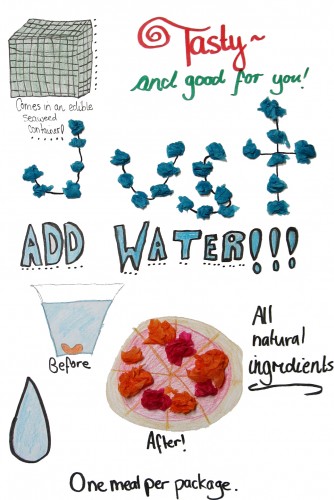The young and the not-so-young alike have much to gain from putting an effort into climate change education. [15 June 2010 | Peter Boyer]
Hidden in the global debate about the science behind man-made climate change is a simple truth: the argument isn’t about science at all, but about something else altogether, something much harder to grasp and even harder to deal with.

JUST ADD WATER: A “Fresh!” workshop idea for easily-transportable food with edible packaging, by primary student Joanna Ellis
It’s a truth revealed not in verbal engagement, but in anger and aggression, or in silence and reticence. The debate isn’t about what’s said, but what’s not said. It’s a debate in which the meaning of our words matters less than the way we utter them.
The science confronts us with something utterly new to human experience. We’re being forced to re-evaluate things that all our lives we’ve taken for granted and to consider profound challenges to our lifestyles, our values, our hopes, beliefs and faiths.
Sure, in the prehistoric past humans managed to survive sudden, even catastrophic climate change events. We came to accept these as acts of God, but our fate today has nothing to do with God and everything to do with us. The fact that redemption is in our hands is a very daunting prospect.
So daunting that instead of engaging with each other to secure real, physical outcomes, we seem to want to retreat into isolation, receiving science’s message not as guidance but as a threat. Leaders and led alike react in an all-too-human way, with distracting bravado and spin; sometimes hostility.
All our lives, the illusion that civilisation’s structures are somehow natural, fundamental and indestructible has been instilled into us. This mindset is blocking us from doing what we have to do.
Seeing this problem, some have turned to people whose minds aren’t so locked in place: our children. In search of new ways of looking at the world and our place in it, teacher and student are together beginning a journey along less-travelled paths that promises to be a rich source of inspiration for a flagging adult population.
Education for a sustainable future takes many forms. Growing numbers of teachers in schools, working from a limited base in the current curriculum, are getting their students to undertake practical exercises and experiments that look at the big questions ahead, involving science, technology, economics, politics and community living.
Another approach has been taken by a Glenorchy-based educational program, “Children of the Earth”, the brainchild of Michael Anderson and Sharlene Broughton.
This program seeks to raise children’s awareness of the world they live in, to explore connections in the web of life, and to instil an awareness that everyone has something to give. But because it’s an extra-curricular activity using hired venues, its success depends on the engagement of parents, and that’s a tough assignment in the absence of active support from schools.
“Fresh!” is a third approach, a dynamic State-wide project to raise awareness of climate change using creative exercises with words, pictures and performance. Its major project is a “climate change garden” installation by artist Nicolas Low to be mounted at the national Regional Arts Australia conference in Launceston in late August.
Starting a year ago, “Fresh!” is the product of a partnership between Tasmanian Regional Arts and the University of Tasmania’s School of Geography and Environmental Studies. The idea, first devised by the school’s head, Prof Elaine Stratford, is to draw on this island people’s independent thinking and strong sense of place to help everyone to prepare for future challenges.
The Launceston installation, titled “A map of a dream of the future”, will draw on the work of select groups of Years 5 and 6 Tasmanian primary students who for the past few months have been visualising how the issues of migration, transport, shelter, and food and water supplies will pan out in Tasmania in 2100, in a world transformed by climate change.
Children’s ideas produced in school holiday workshops around Tasmania over the past fortnight will be uploaded into a virtual world, to form part of the installation.
Fresh! educational coordinator Josie Hurst, is optimistic about prospects for changing how young Tasmanians view their future. She’s found young Tasmanians respond well to honest presentation of the current science of climate change, especially when they think about what they can do.
The project’s technique of getting children to envisage a future life without fossil fuels has had some surprisingly positive results. An enduring memory for Josie Hurst will be the words of one highly-motivated Grade Sixer: “The future sounds nicer than I’d thought it would be.”
The Launceston installation will be an impressive showcase of the imaginative talent of our children as they begin preparing for a more resilient future. But what’s more important is where projects like Fresh! or Children of the Earth might lead to.
Sustainability is to be a major theme running through the national schools curriculum currently being developed, but it has yet to surface in written form and we can’t expect it to take full effect in classrooms for some years yet.
We need Tasmanian educational administrators to help fill that gap, just as we need our children to become an active part of the climate change debate — not just for their sakes, but also for their hidebound elders whose old mindsets are proving so difficult to shake. All power to them and their inspirational teachers.
• For more information on Children of the Earth, telephone 62730397. You can download Fresh’s “Map of a dream of the future” educational materials by clicking here.

Pingback: Climate education is a two-way process | Climate Tasmania edu university